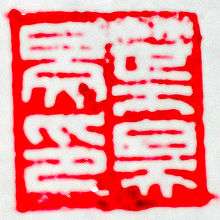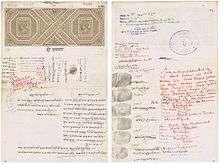Signature
A signature (/ˈsɪɡnətʃər/; from Latin: signare, "to sign") is a handwritten (and often stylized) depiction of someone's name, nickname, or even a simple "X" or other mark that a person writes on documents as a proof of identity and intent. The writer of a signature is a signatory or signer. Similar to a handwritten signature, a signature work describes the work as readily identifying its creator. A signature may be confused with an autograph, which is chiefly an artistic signature. This can lead to confusion when people have both an autograph and signature and as such some people in the public eye keep their signatures private whilst fully publishing their autograph.

Function and types


The traditional function of a signature is to permanently affix to a document a person's uniquely personal, undeniable self-identification as physical evidence of that person's personal witness and certification of the content of all, or a specified part, of the document. For example, the role of a signature in many consumer contracts is not solely to provide evidence of the identity of the contracting party, but also to provide evidence of deliberation and informed consent. In many countries, signatures may be witnessed and recorded in the presence of a notary public to carry additional legal force. On legal documents, an illiterate signatory can make a "mark" (often an "X" but occasionally a personalized symbol), so long as the document is countersigned by a literate witness. In some countries, illiterate people place a thumbprint on legal documents in lieu of a written signature.
In the United States, signatures encompass marks and actions of all sorts that are indicative of identity and intent. The legal rule is that unless a statute specifically prescribes a particular method of making a signature it may be made in any number of ways. These include by a mechanical or rubber stamp facsimile. A signature may be made by the purported signatory; alternatively someone else duly authorized by the signatory, acting in the signer's presence and at the signatory's direction, may make the signature.[2]
Many individuals have much more fanciful signatures than their normal cursive writing, including elaborate ascenders, descenders and exotic flourishes, much as one would find in calligraphic writing. As an example, the final "k" in John Hancock's famous signature on the US Declaration of Independence loops back to underline his name. This kind of flourish is also known as a paraph.
Paraphe is a term meaning flourish, initial or signature in French.[3] The paraph is used in graphology analyses.
Several cultures whose languages use writing systems other than alphabets do not share the Western notion of signatures per se: the "signing" of one's name results in a written product no different from the result of "writing" one's name in the standard way. For these languages, to write or to sign involves the same written characters. Also see Calligraphy.
Mechanically produced signatures


Special signature machines, called autopens, are capable of automatically reproducing an individual's signature. These are typically used by people required to sign a lot of printed matter, such as celebrities, heads of state or CEOs.[4] More recently, Members of Congress in the United States have begun having their signature made into a TrueType font file. This allows staff members in the Congressman's office to easily reproduce it on correspondence, legislation, and official documents. In the East Asian languages of Chinese, Japanese, and Korean, people traditionally use stamp-like objects known as name-seals with the name carved in tensho script (seal script) in lieu of a handwritten signature.
Wet signatures
Some government agencies require that professional persons or official reviewers sign originals and all copies of originals to authenticate that they personally viewed the content. In the United States this is prevalent with architectural and construction plans. Its intent is to prevent mistakes or fraud but the practice is not known to be effective.
Detection of forged signatures
Handwriting experts say "it is extremely difficult for anyone to be able to figure out if a signature or other very limited writing sample has been forged,"[5] High volume review of signatures, to decide if a signature is true or forged, occurs when election offices decide whether to accept absentee ballots arriving from voters,[6] and possibly when banks decide whether to pay checks.[7][8] The highest error rates in signature verification are found with lay people, higher than for computers, which in turn make more errors than experts.[9]
There have been concerns that signature reviews improperly reject ballots from young and minority voters at higher rates than others, with no or limited ability of voters to appeal the rejection.[10] [11] When errors are made with bank checks, the payer can ask the bank for corrections.
Researchers have published error rates for computerized signature verification. They compare different systems on a common database of true and false signatures. The best system falsely rejects 10% of true signatures, while it accepts 10% of forgeries. Another system has error rates on both of 14%, and the third-best has error rates of 17%.[12][13] It is possible to be less stringent and reject fewer true signatures, at the cost of also rejecting fewer forgeries.[14] Computer algorithms:
look for a certain number of points of similarity between the compared signatures ... a wide range of algorithms and standards, each particular to that machine's manufacturer, are used to verify signatures. In addition, counties have discretion in managing the settings and implementing manufacturers' guidelines ... there are no statewide standards for automatic signature verification ... most counties do not have a publicly available, written explanation of the signature verification criteria and processes they use.[15]
In an experiment, experts rejected 5% of true signatures and 71% of forgeries. They were doubtful about another 57% of true signatures and 27% of forgeries. If computer verification is adjusted to reflect what experts are sure about, it will wrongly reject 5% of true signatures and wrongly accept 29% of forgeries. If computers were adjusted more strictly, rejecting all signatures which experts have doubts about, the computers would set aside 62% of true signatures, and still wrongly accept 2% of forgeries. Lay people made more mistakes and were doubtful less often, though the study does not report whether their mistakes were to accept more forgeries or reject more true signatures.[16]
Voters with short names are at a disadvantage, since experts make more mistakes on signatures with fewer "turning points and intersections." Participants in this study had 10 true signatures to compare to, which is more than most postal ballot verifications have.[16] A more recent study for the US Department of Justice confirms the probabilistic nature of signature verification, though it does not provide numbers.[9]
Online usage
In e-mail and newsgroup usage, another type of signature exists which is independent of one's language. Users can set one or more lines of custom text known as a signature block to be automatically appended to their messages. This text usually includes a name, contact information, and sometimes quotations and ASCII art. A shortened form of a signature block, only including one's name, often with some distinguishing prefix, can be used to simply indicate the end of a post or response. Some web sites also allow graphics to be used. Note, however, that this type of signature is not related to electronic signatures or digital signatures, which are more technical in nature and not directly understandable by humans. On Wikipedia, an online wiki-based encyclopedia edited by volunteers, the contributors "sign" their comments on talk pages with their username (only the username holder has the right to digitally affix their signature).
Art

The signature on a painting or other work of art has always been an important item in the assessment of art. Fake signatures are sometimes added to enhance the value of a painting, or are added to a fake painting to support its authenticity. A notorious case was the signature of Johannes Vermeer on the fake "Supper at Emmaus" made by the art-forger Han van Meegeren. However, the fact that painters' signatures often vary over time (particularly in the modern and contemporary periods) might complicate the issue. The signatures of some painters take on an artistic form that may be of less value in determining forgeries.
Copyright
Under British law, the appearance of signatures (not the names themselves) may be protected under copyright law.[17]
Under United States copyright law, "titles, names [I c...]; mere variations of typographic ornamentation, lettering, or coloring" are not eligible for copyright;[18] however, the appearance of signatures (not the names themselves) may be protected under copyright law.[17]
Uniform Commercial Code
Uniform Commercial Code §1-201(37) of the United States generally defines signed as "using any symbol executed or adopted with present intention to adopt or accept a writing." The Uniform Commercial Code §3-401(b) for negotiable instruments states "A signature may be made (i) manually or by means of a device or machine, and (ii) by the use of any name, including a trade or assumed name, or by a word, mark, or symbol executed or adopted by a person with present intention to authenticate a writing."
See also
- Autograph club
- Biometric signature as form of the electronic signature
- Initials
- Diabolical signature, said to identify the demons in diabolical pacts
- Images of signatures
- manu propria (m.p.)
- Monogram
- Round-robin (document), a signed document where the signatures are arranged in a circle
- Royal sign-manual
- Signum manus
- Tughra
References
- "John Hancock". Merriam-Webster. Retrieved 2 August 2014.
- 80 Corpus Juris Secundum, Signatures, sections 2 through 7
- French to English translation by CollinsDictionary.com. Collins French-English Dictionary - Complete & Unabridged 11th Edition. Retrieved November 09, 2012.
- https://www.politico.com/story/2013/01/autopen-barack-obama-10-facts-085720
- Armitage, Susie (2018-11-05). "Handwriting Disputes Cause Headaches for Some Absentee Voters". ProPublica. Retrieved 2020-06-01.
- "Voting Outside the Polling Place: Absentee, All-Mail and other Voting at Home Options". www.ncsl.org. Retrieved 2020-07-02.
- "What Is Automated Signature Verification?". SQN Banking Systems. Retrieved 2020-08-07.
- Mayhew, Stephen (2012-05-14). "Banks Are Now Embracing The Newer And Tougher Signature Verification System". Biometric Update. Retrieved 2020-08-07.
- Srihari, Sargur N. (2010-08-12). "Computational Methods for Handwritten Questioned Document Examination 1 FINAL REPORT to Dept. of justice Award Number: 2004-IJ-CX-K050". citeseerx.ist.psu.edu. Retrieved 2020-06-19.
- Smith, Daniel (2018-09-18). "Vote-By-Mail Ballots Cast in Florida" (PDF). ACLU-Florida. Retrieved 2020-06-01.
- Wilkie, Jordan (2018-10-12). "Exclusive: High Rate of Absentee Ballot Rejection Reeks of Voter Suppression". Who What Why. Retrieved 2020-06-18.
- These systems handle scanned ("offline") signatures from multiple people ("WI, writer-independent"). Hafemann, Luiz G., Robert Sabourin and Luiz S. Oliveira (2017-10-16). "Offline Handwritten Signature Verification - Literature Review". IEEE. Retrieved 2020-07-17.
- Bibi, Kiran; Naz, Saeeda; Rehman, Arshia (2020-01-01). "Biometric signature authentication using machine learning techniques: Current trends, challenges and opportunities". Multimedia Tools and Applications. 79 (1): 289–340. doi:10.1007/s11042-019-08022-0. ISSN 1573-7721.
- Igarza, Juan; Goirizelaia, Iñaki; Espinosa, Koldo; Hernáez, Inmaculada; Méndez, Raúl; Sanchez, Jon (2003-11-26). Online Handwritten Signature Verification Using Hidden Markov Models. CIARP 2003. 2905. pp. 391–399. doi:10.1007/978-3-540-24586-5_48.
- "Signature Verification and Mail Ballots: Guaranteeing Access While Preserving Integrity" (PDF). Stanford University. 2020-04-15. Retrieved 2020-06-01.
- Sita, Jodi; Found, Bryan; Rogers, Douglas K. (September 2002). "Forensic Handwriting Examiners' Expertise for Signature Comparison". Journal of Forensic Sciences. 47 (5): 15521J. ISSN 0022-1198.
- Spilsbury, Sallie (2000). Media Law. Cavendish Publishing. p. p. 439. ISBN 978-1-85941-530-6.
An individual's signature may be protected under law as an artistic work. If so, the unauthorised reproduction of the signature will infringe copyright. The name itself will not be protected by copyright; it is the appearance of the signature which is protected.
- "Copyright Basics Archived 2011-03-05 at the Wayback Machine", United States Copyright Office. Retrieved 15 March 2011.
External links
| Wikimedia Commons has media related to Signatures. |
Wikidata has the property:
|
| Look up signature in Wiktionary, the free dictionary. |